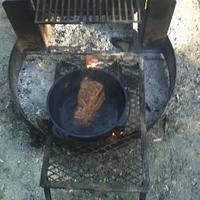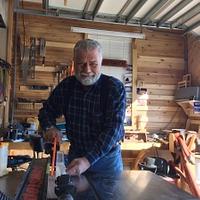Building a new workshop
Well…in an effort to keep the missus happy “we” decided to buy a new house and move. It’s been about a month now and we are pretty settled in except for one, in my mind, major drawback. I lost my workshop. All my tools and supplies are piled up in one half of the two car garage. I know what you are thinking and forget it, SWMBO has decreed that no woodworking will take place in “her” new house. I have been informed that I am to build a separate building for my hobby.
What I need are some ideas and suggestions. My new shop will be 12′×18′ with a 10’ ceiling. Other than that it’s wide open. Can you give me some websites to look at? Pictures of your own shops? Etc.
Thanks all!
You never learn anything by doing it right. You only learn that you didn't screw it up.
20 Replies
I don’t have anything that will help you but I would make it bigger if you have that option.
All my tools are on wheels and I share the 2 car garage with my wife’s car.
That means I take her car out on the weekend and pull the tools I need. When the weekend is over I pull everything back.
Abbas, Castro Valley, CA
I would love to make a bigger shop, unfortunately I am limited by city bylaws to no more than 216 sq feet….thus 12×18.
I tried to talk her into the shared arrangement as well, but we live in Canada and the snow gets a bit much. She has been dreaming of a heated garage for years. The things we men sacrifice for our women…..LOL.
You never learn anything by doing it right. You only learn that you didn't screw it up.
I know what you mean:)
If I were to build one, I would have the following:
-Hardwood floor cement is hard on my soles standing for long time
-subpanel with enough electricity (220 /110)
A lot of light
-A sepearate mini shed for the dust collector adjacent to the building
-build out the main dust collector to 6" ( preferable metal) and reducer where you need them. Of course blast gates as needed. Grounded of course
-Lot’s of storage so stuff don’t pile up on each other
-If you do a lot of work mabye an isolated space for finishing
-Since you mention snow, don’t forget the heating
Good luck with your build and please post as you so we learn as well:)
Abbas, Castro Valley, CA
A wood stove would be part of my dream shop. And more windows. But most of all – a flat and level floor. My garage is pitched like most I think.
But now that I’m done day dreaming, use that height you’re planning to the greatest storage benefit you can get out of it, including a usable attic if you can swing it. Maybe even lower the ceiling to create a nice mezzanine above you can walk in. And store the lawn equipment in the garage. That’s the wife’s sacrifice.
Losing fingers since 1969
My shop is 10×20, so I have quite a bit of experience working in tiny spaces. I second the motion about putting the dust collector in a separate space. If you are cunning about it you can make it look like a free standing outdoor cabinet. Insulate it, weather strip the doors, and make sure you put in some sort of return air duct so you aren’t pumping your shop heat outside and making your shop cold. Put your air compressor in that space too.
If you can get away with it, build taller. That will allow you to have plenty of overhead lumber storage. All of my clamps, and many of my hand tools hang from the rafters in my shop to save space.
Everything is on retractable wheels so you can move it around as nesessary. Make your workbench the correct height to easily serve as a table saw out feed table too. Make a Masonite cover for your table saw with lips around it to hold it steadily in place. This let’s you retract the blade and use your table saw as a finishing or assembly table without worrying about spills.
Try to make everything in the shop easily movable, and multipurpose.
Finally, I second the motion about lots of lights. Forget florescent. LED bulbs are now cheap enough that you can install lots of old fashioned light sockets in the ceilings and light with LED for less. Put a few outlets in your switched light circuit to plug in things that shouldn’tbe left on, like radios and battery chargers, so when you shut off your shop lights, they go off too.
That’s about all I can think of at the moment
Here’s where I would look for ideas
woodworking classes, custom furniture maker
Jeff, great idea with the switched outlets. I’m going to do some rewiring today.
Losing fingers since 1969
Thanks Brian. That discovery was actually a happy accident. When I wired up my lighting circuit I was running low on supplies and all I had left was double gang outlet boxes. I put two outlets in each double box in an attempt to hide my poor project planning skills. “See? I meant to do that!” Once it was installed, I found those extra outlets super useful. :-)
Done. Radio and charger now wired to the light switch.
Losing fingers since 1969
does it mean you cant charge when the light is off ?
Most of the time I charge during the night so the tools are ready again for next time.
I like the idea though. Maybe I will wire a second switch next to the light switch.
Abbas, Castro Valley, CA
No charging at night. But the new outlet is right next to the old ones so if I need to charge overnight I can just plug it in to the other one. It’s really for the radio. I always forget to turn it off.
Losing fingers since 1969
Glen
lots of good suggestions ,If your budget will allow think about radiant floor heating and putting some of your dust collection ducking,air lines and electrical in the floor,doing this eliminates having to have ducking ,wires and air hoses on top of the floors to trip over. I also agree with having your compressor and dust collection outside of the building in a separate little-attached shed ,this saves floor space and eliminates lots of noise,it also is safer given that some compressor tanks have been know to blow up when they get old. When laying out your tools start with you table saw as the beginning point with enough room to have long infeed and outfeed then place other tools that are used in conjunction with you table saw close by,like your jointer and chop saw.
I agree with having taller ceilings (mine are 14") to make it possible to stand wood on end and for more storage. I also agree with having plenty of outlets 110 and 220. I had a sperate 200 amp service installed in my shop. Depending on the area your in think about security The only windows I have are fixed and are only 1′ × 3′ at the top of my 14’ walls. I also made sure I had a door in the front and rear of my shop as a safety feature in case of fire.
Here’s a link for a shop layout planner that I recommend to my students.
http://grizzly.com/workshopplanner
woodworking classes, custom furniture maker
How does that Brad Pasley song go??? I’m sure gonna miss her. ?
Glen,
Does code or restrictive covenant allow for a shed to be attached to the side so you can put dust collection and Air compressor in that? That saves a lot of space. I would have a hanging heater and maybe skylights as to not take anymore wall or floor space….that way you can move the equipment out you are using and put the things back you not.
I have a three and a half stall garage that all my stuff is on wheels and stored in the third stall for parking vehicles in the other space. I pull the cars out and if I am turning, I have a turning set up…if I am doing flat work, likewise I have a set up for it. You learn to be creative. Is it ideal…no….but it’s cheaper than a divorce and easier than moving!!!
What A1Jim says has a lot of merit too…..if you can put up 14’ walls that is a possible short second story storage at least in part of it. Find a way to cheat the system!!!
Mike
Mike
Outlets , outlets and more outlets , . Also when I rewired my garage with conduit , i I put out lets in the ceiling where the lights go . Then I use a light bulb adapter ( you screw the bulb into the adapter and then plug it in ) . Plus a retractable out let cord in the ceiling over your your workbench . Saves walking over cords all day . I have a 4 gang outlet box on the side of my work bench , I plug it into the over head power source .
Wheaties
I don’t know where you stein your shop building project, but for me, a really big help was to make cutouts of my equipment and move them around on a scale plan. I remember there was a website that you could do this on or download the cutouts. Suggest “googling” shop layout templates or something like that.
I just moved in the fall into my 4th shop in the last 6 years. The last 2 shops I’ve had, I’ve built. Here’s what I’ve learned, (most of it mentioned already)
-build more lights into your plan than you think necessary. Then when you think you have enough lights, put more. Especially with 10 ft ceilings. My current shop is 25×40 with 10ft ceilings and I have almost 7 rows of double fixture fluorescent lights.
-wooden subfloor to walk on; my first shop was in a small garage that had a wooden floor. It was great, no damage to my tools if I dropped them, easy to clean and no aching legs after a few hours in the shop. Every shop since has had a wooden subfloor.
-20amp recepticles every 4ft
-consider building a small shed outside for most of your wood storage. Especially in a small shop, wood storage takes up a huge amount of space.
Rob, Sault Ste. Marie, Ontario
Glen, did you ever finish your shop? I built a 16' x 22' (minus ~8" on both those dimensions for actual floor space) with 12' walls. I'm now ready to run power and 240V w/30A is plenty if I keep it as a shed in it's current state, if I haul the crap out and haul my shop up there, 100A would be far more desireable to run more than 1 thing at a time. A mezzanine about 9' off the back wall will give me 6'6" of head room and not much upstairs but plenty for storage. My uncle has promised me a 24KBTU mini split he'll no longer need for his shop remodel into a 1st floor master. I've also run PVC conduit under the slab from where I'm certain I would place the jointer & tablesaw to under the wall though I've yet to bust the 1/2" of concrete covering those.
I'm struggling with how bad I want to use that as my shop knowing to just maintain the temperature & combat humidity will cost 4-5x as much/mo as the room A/C I've already purchased for the garage. Backing my truck to the garage to unload lumber & materials is now quite easy, that requires driving across the lawn if the shed becomes the shop and would be impossible when it's wet without destroying the turf. I've already purchased everything to run 30A power up there, additionally pulling 100A up there would add ~$1300 on top of my current investment. It's not yet insulated, I want to do that only after I have a better vision of what that will be used for, really a question of when moreso than if at this point.
Anyone else planning, currently building or have recently built a dedicated shop? This seems like as good a place as any to detail planning, construction and 20/20 hindsight changes that would have been undertaken differently.
BTW, my 18K BTU minisplit is pretty inexpensive to operate -- between $1 to $2 per day (@$0.11/KWH) when I run it. That 24k unit is way oversized for a 16x22' space. Even in my 20x20 garage with limited insulation (none on the exterior walls) 18k has handled the 100°+ temperatures this year with no problem. You might be better off buying a new 12k unit, which should be sufficient for your space. Depending upon your local climate, a 9K unit might be enough. Pioneer minisplit units are less than $1000, come pre-charged so you can install them yourself, and you only need to evacuate and test the connections on the lines, which you can also do yourself if you have or buy a pump and manifold.
--Nathan, TX. Hire the lazy man. He may not do as much work but that's because he will find a better way.

















